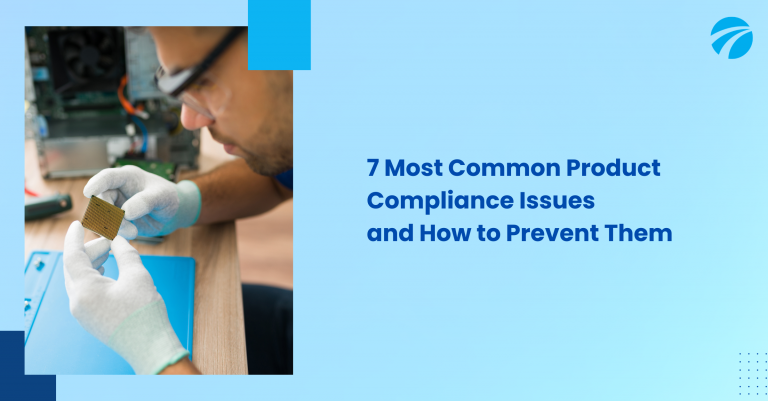Product compliance is vital to manufacturing, buying, importing, and selling goods. It is essential to ensure that your products adhere to regulatory requirements not only for legal reasons but also to protect the well-being of end consumers and maintain your brand’s reputation. Manufacturers, buyers, importers, and brands must know common compliance issues when importing products into countries like Europe, the USA, or Saudi Arabia.
This article will delve into the seven most common product compliance issues and provide practical solutions to prevent them, ultimately offering valuable insights for a smooth and compliant business operation.

1. Inadequate or Incorrect Labeling
Labeling is crucial in product compliance, as it conveys important information such as warnings, symbols, instructions for use, and product origin. Non-compliant or inaccurate labels can result in fines, product recalls, and damage your brand’s reputation. To ensure accurate and compliant labeling, follow these practical steps:
Research and understand local regulations:
Familiarize yourself with the specific labeling requirements for each target market by consulting local regulations and standards. This will help you avoid costly mistakes and ensure your product’s compliance.
Collaborate with suppliers and designers:
Work closely with your suppliers and design team to create compliant labels that meet the requirements. Communication is key to ensuring all parties understand the importance of accurate and compliant labeling.
Test label durability:
It’s essential to ensure important information remains legible throughout the product’s life cycle. Conduct durability tests on labels to ensure they can withstand various conditions, such as exposure to moisture, sunlight, and wear and tear.
2. Non-Compliant Materials and Chemicals
Utilizing restricted or hazardous materials in your products may result in severe compliance challenges. It’s essential to adhere to international regulations and guidelines that govern the use of specific substances, such as lead, phthalates, and formaldehyde, to avoid potential penalties and reputational damage.
To optimize your approach to materials and chemicals compliance, consider the following strategies:
Research and understand relevant regulations:
Familiarize yourself with pertinent legislation, such as the European Union’s Registration, Evaluation, Authorisation and Restriction of Chemicals (REACH) and Restriction of Hazardous Substances or RoHS compliance, as well as the United States Consumer Product Safety Improvement Act (CPSIA). Keeping abreast of these regulations will help you stay informed about any updates or changes.
Prioritize the use of compliant materials:
Actively seek out and select materials that meet the necessary regulatory standards. Make compliance a key factor in your decision-making process when choosing materials and suppliers.
Engage with reliable and trusted suppliers:
Establish partnerships with reputable suppliers who consistently commit to meeting regulatory requirements. They should be transparent about their practices, allowing you to verify their compliance with relevant laws.
Implement regular supply chain audits:
Schedule routine quality control audits of your supply chain to ensure ongoing material and chemical restrictions adherence. This proactive approach will help you identify potential quality issues before they escalate, minimizing non-compliance risk.
Educate and train your staff:
Equip your team with the knowledge and skills necessary to maintain compliance by providing regular training on relevant regulations and best practices. This investment will empower your employees to make informed decisions and uphold your company’s commitment to safe and responsible material use.
3. Failure to Meet Safety Standards
Enhancing Product Safety: A Comprehensive Guide to Compliance with International Standards
To protect consumers and maintain market access, ensuring your products comply with international safety standards such as the CE marking in Europe, UL listing in the USA, or SASO conformity in Saudi Arabia is crucial. Non-compliant products risk legal repercussions, recalls, and loss of market access. Here, we provide a comprehensive guide to help you navigate the complexities of product safety compliance.
Research and Understand Relevant Safety Standards:
Begin by thoroughly researching your product’s and target market’s appropriate safety standards. Familiarize yourself with the requirements and guidelines set forth by regulatory bodies, such as the European Union, the United States Consumer Product Safety Commission, or the Saudi Standards, Metrology and Quality Organization. By understanding these requirements, you can make informed decisions about product design and manufacturing processes.
Develop and Implement a Comprehensive Quality Management System (QMS):
A well-designed QMS is essential for maintaining consistent product quality and ensuring compliance with safety standards. Implement a QMS focusing on continual improvement, emphasizing risk management, documentation, and corrective actions. This will help your organization identify and address potential issues before they escalate into more significant problems.
Collaborate with Accredited Third-Party Testing Labs:
Partner with reputable, accredited third-party testing labs to verify that your products meet the required safety and performance standards. Regular product testing and certification ensure your products consistently adhere to the specified regulations. In addition, third-party product certification adds credibility to your brand and assures consumers, retailers, and regulatory authorities.
Train and Educate Your Workforce:
Empower your employees with the knowledge and skills required to maintain compliance with safety standards. Provide comprehensive training and education programs covering relevant regulations, internal QMS procedures, and best practices. An informed and skilled workforce ensures consistent product quality and compliance.
Keep Up-to-Date with Regulatory Changes:
Regulations and safety standards are subject to change over time. Stay informed about updates and revisions to ensure that your products remain compliant. Establish a system for monitoring and reviewing regulatory changes, and revise your QMS, product design, and manufacturing processes as needed.
4. Non-Compliant Packaging
Packaging plays a crucial role in product compliance, providing protection and information and contributing to a product’s overall sustainability. Common packaging compliance issues include incorrect dimensions, insufficient protection, and the use of non-compliant materials.
To achieve compliant packaging:
- Consult local regulations for packaging requirements specific to your product and target market.
- Work with experienced packaging suppliers that understand compliance requirements and can provide appropriate solutions.
- Consider the environmental impact of your packaging and opt for sustainable materials whenever possible.
Packaging Inspection is an essential aspect of product compliance, as it safeguards the product, conveys critical information, and plays a vital role in its overall sustainability. To help you ensure that your packaging meets all requirements, we’ve outlined key steps to achieve compliant packaging that delivers value to you and your customers. This guide is designed to be NLP-friendly, making it accessible to a wide audience.
- Provide Clear and Accurate Information: Ensure that your packaging communicates all required information, such as product ingredients, warnings, or usage instructions, clearly and concisely. This helps maintain compliance, fosters customer trust, and enhances the user experience.
- Understand Local Regulations: Regulations vary based on product type, location, and industry. Staying informed on these regulations will help you avoid common compliance issues such as incorrect dimensions, insufficient protection, or using non-compliant materials.
- Embrace Sustainability: Incorporate eco-friendly materials and practices into your packaging design whenever possible. This contributes to your product’s overall sustainability and appeals to environmentally-conscious consumers. Sustainable packaging materials can include recycled, biodegradable, or compostable options, depending on your product’s needs and the preferences of your target market
- Regularly Review and Update: Compliance requirements can change over time. Stay up-to-date on any updates or amendments to local regulations, and be prepared to adjust your packaging accordingly. This proactive approach will help you maintain compliance and minimize any disruptions to your business.
5. Intellectual Property Infringements

Respecting intellectual property rights, such as patents, trademarks, and copyrights, is essential for maintaining a lawful and ethical business. Infringements can lead to legal disputes, financial penalties, and damage to your brand’s reputation.
To avoid IP issues:
- Conduct thorough research before developing or sourcing a new product to ensure it does not infringe on existing intellectual property.
- Seek advice from legal experts or intellectual property attorneys if you have concerns about potential infringement.
- Register your intellectual property to protect your own innovations and designs.
6. Insufficient Documentation and Record-Keeping
Effective documentation and record-keeping are crucial in showcasing your dedication to meeting regulatory requirements. Common pitfalls in documentation include incomplete or missing certificates, test reports, or declarations. Here’s how you should arrange your documents and record keeping.
- Create a comprehensive inventory of essential documents: Compile a detailed list of required documents for each product, target market, and regulatory authority. This will streamline the process of gathering and organizing the necessary paperwork for product compliance.
- Utilize a centralized document management system (DMS): Implement a DMS to efficiently store, monitor, and update all compliance-related documents in a single location. This will improve the organization and ensure easy access to vital information when needed.
- Stay informed about evolving regulations: Regularly monitor changes in regulations and promptly update your documentation to stay in line with the latest requirements. Staying well-informed will help you maintain an accurate and up-to-date document repository.
- Establish a systematic review process: Implement a routine review procedure to verify the accuracy and completeness of your documentation. This proactive approach will help identify gaps or discrepancies before they become significant issues.
7. Inadequate Quality Control and Inspection
Quality control and inspection play a crucial role in ensuring product compliance. Poor production processes and consistent product quality can lead to non-compliant products entering the market.
To establish effective quality control and inspection:
- Implement strict quality control measures throughout the production process, including raw material inspection, in-process inspection, and final product inspection.
- Conduct regular factory audits to assess your suppliers’ capabilities and adherence to compliance requirements.
- Partner with reputable inspection companies to independently assess your products and processes.
How Tetra Inspection Can Ensure Product Compliance
Global brands trust Tetra Inspection for comprehensive product compliance services. Through our years of experience, we help reduce the risk of non-compliance and associated penalties while streamlining compliance processes for our clients. We ensure products meet safety, quality, and performance standards through meticulous product inspection services. Our hands-on factory audit is designed for early identification and correction of non-compliance issues, preventing costly recalls and brand damage.
Our compliance consulting services guide through complex regulatory frameworks, as our team of experts stays current on regulation changes and best practices.
By collaborating with us at Tetra Inspection, you can make your compliance processes more efficient and cost-effective.
Get in touch with us today to learn more about our product compliance services.

